A) Point G is unattainable with current resources, but point F is attainable.
B) All resources are fully employed at point F but there is unemployment at point G.
C) More output can be produced at point F but no additional output can be produced at point G.
D) This economy produces more cookies at point G than at point F.
F) C) and D)
Correct Answer

verified
Correct Answer
verified
Multiple Choice
Which of these terms are used interchangeably?
A) "goods and services" and "inputs"
B) "goods and services" and "factors of production"
C) "inputs" and "factors of production"
D) "land, labor, and capital" and "goods and services"
F) A) and D)
Correct Answer

verified
Correct Answer
verified
Multiple Choice
Policies such as rent control and trade barriers persist in spite of the fact that economists are virtually united in their opposition to such policies, probably because
A) economists have not yet convinced the general public that the policies are undesirable.
B) economists engage in positive analysis, not normative analysis.
C) economists have values that are different from the values of most non-economists.
D) economists' theories are not easily confirmed or refuted in laboratory analysis.
F) C) and D)
Correct Answer

verified
Correct Answer
verified
Short Answer
Figure 2-14 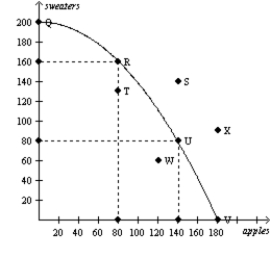 Consider the production possibilities curve for a country that can produce sweaters, apples in bushels), or a combination of the two.
-Refer to Figure 2-14. What is the opportunity cost of moving from point T to point R?
Consider the production possibilities curve for a country that can produce sweaters, apples in bushels), or a combination of the two.
-Refer to Figure 2-14. What is the opportunity cost of moving from point T to point R?
Correct Answer

verified
Correct Answer
verified
Multiple Choice
Congress relies on economists at the Congressional Budget Office to
A) enforce the nation's antitrust laws.
B) set the nation's monetary policy.
C) provide evidence that incumbent members of Congress are performing well in their jobs.
D) provide independent evaluations of policy proposals.
F) A) and C)
Correct Answer

verified
Correct Answer
verified
Multiple Choice
Figure 2-11 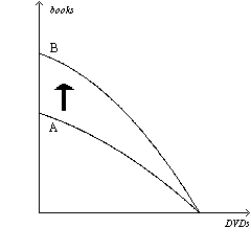 -Refer to Figure 2-11. The shift of the production possibilities frontier from A to B illustrates
-Refer to Figure 2-11. The shift of the production possibilities frontier from A to B illustrates
A) simultaneous technological advances in the book and DVD industries.
B) a reallocation of resources away from the production of DVDs and toward the production of books.
C) economic growth.
D) All of the above are correct.
F) B) and C)
Correct Answer

verified
Correct Answer
verified
Multiple Choice
In the circular-flow diagram, which of the following items flows from households to firms through the markets for the factors of production?
A) goods and services
B) land, labor, and capital
C) dollars spent on goods and services
D) wages, rent, and profit
F) B) and D)
Correct Answer

verified
Correct Answer
verified
Multiple Choice
Figure 2-4 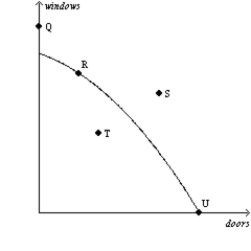 -Refer to Figure 2-4. This economy cannot produce at which points) ?
-Refer to Figure 2-4. This economy cannot produce at which points) ?
A) Q
B) Q, S
C) Q, S, T
D) S
F) None of the above
Correct Answer

verified
Correct Answer
verified
True/False
The President counts among his economic advisors the Congressional Budget Office.
B) False
Correct Answer

verified
Correct Answer
verified
Multiple Choice
Figure 2-19
In the following graph the x-axis shows the number of times a commuter rail train stops at a station per hour and the y-axis shows the number of commuter rail passengers per hour.
Commuter Rail Passengers by Frequency of Service 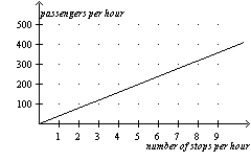 -Refer to Figure 2-19. Which of the following conclusions should not be drawn from observing this graph?
-Refer to Figure 2-19. Which of the following conclusions should not be drawn from observing this graph?
A) There is a positive correlation between the frequency of service and the number of passengers.
B) When there are 5 stops per hour, there are approximately 200 passengers.
C) More stops per hour is associated with more passengers per hour.
D) No other factors besides the frequency of service affect the number of passengers.
F) A) and B)
Correct Answer

verified
Correct Answer
verified
Multiple Choice
Suppose that someone makes the argument that because empty alcohol containers are found at many accidents, the containers cause accidents. This would be an example of
A) sound logic.
B) reverse causality.
C) omitted variables.
D) bias.
F) A) and B)
Correct Answer

verified
Correct Answer
verified
True/False
The scientific method can be applied to the study of economics.
B) False
Correct Answer

verified
Correct Answer
verified
True/False
When a production possibilities frontier is bowed outward, the opportunity cost of one good in terms of the other depends on how much of each good is being produced.
B) False
Correct Answer

verified
Correct Answer
verified
True/False
Economists believe that production possibilities frontiers rarely have a bowed shape.
B) False
Correct Answer

verified
Correct Answer
verified
True/False
The trade-off between the production of one good and the production of another good can change over time because of technological advances.
B) False
Correct Answer

verified
Correct Answer
verified
Multiple Choice
Albert Einstein once made the following observation about science:
A) "The whole of science is nothing more than the refinement of everyday thinking."
B) "The whole of science is nothing more than an interesting intellectual exercise."
C) "In order to understand science, one must rely solely on abstraction."
D) "In order to understand science, one must transcend everyday thinking."
F) All of the above
Correct Answer

verified
Correct Answer
verified
Multiple Choice
John Maynard Keynes referred to economics as an easy subject,
A) at which very few excel.
B) but not as easy as philosophy or the pure sciences.
C) which very few can enjoy.
D) which deals primarily with common sense.
F) All of the above
Correct Answer

verified
Correct Answer
verified
Multiple Choice
Figure 2-18
Relationship between Price and Restaurant Meals 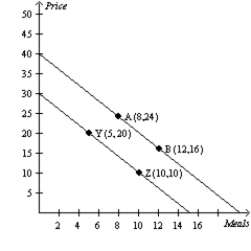 -Refer to Figure 2-18. The slope of the line containing points A and B is
-Refer to Figure 2-18. The slope of the line containing points A and B is
A) -1/2.
B) -2.
C) 1/2.
D) 2.
F) All of the above
Correct Answer

verified
Correct Answer
verified
Multiple Choice
Figure 2-5 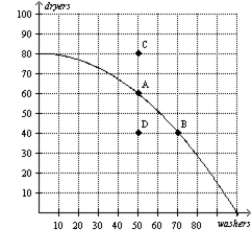 -Refer to Figure 2-5. The opportunity cost of obtaining 40 additional dryers by moving from point D to point C is
-Refer to Figure 2-5. The opportunity cost of obtaining 40 additional dryers by moving from point D to point C is
A) 0 washers.
B) 20 washers.
C) 40 washers.
D) None of the above; the economy cannot move from point D to point C.
F) A) and C)
Correct Answer

verified
Correct Answer
verified
Short Answer
Suppose a war in the Middle East interrupts the flow of crude oil and oil prices skyrocket around the world. For economists, this historical episode serves as a
Correct Answer

verified
Correct Answer
verified
Showing 261 - 280 of 620
Related Exams